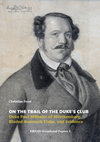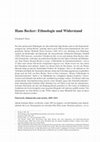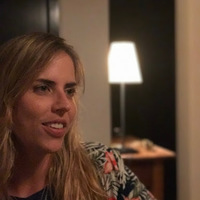Papers by Christian Feest
Michael Kraus (ed.), Die Ethnologische Sammlung der Georg-August-Universität Göttingen , 2024
From the study of deviant skull collected for him in 1816 by Maximilian Prince of Wied, Johann Fr... more From the study of deviant skull collected for him in 1816 by Maximilian Prince of Wied, Johann Friedrich Blumenbach concluded in 1818 that the Botocudos (or at least this skull) were more similar to those of an orangoutang than to those of Africans - a view unchallenged for half a century. In the 1820s Blumenbach finally met live Botocudos who had come to Göttingen, invited them to his home, and found them to be regular human beings.
Michael Kraus (ed.), Die Ethnologische Sammlung der Georg-August-Universität Göttingen , 2024
Brief notice about the part of the important collection of Klamath ethnography collected in 1878 ... more Brief notice about the part of the important collection of Klamath ethnography collected in 1878 by Alphonse Forrer preserved in the Ethnological Collection of the University of Göttingen.
B. Hauser-Schäublin, G. Krüger (eds.), James Cook. Gifts and Treasures from the South Seas. The Cook/Forster Collection, Göttingen/Gaben und Schätze aus der Südsee. Die Göttinger Samm-lung Cook/Forster, 1998
Ethnographic objects from James Cook's voyages from Tierra del Fuego and the Northwest Coast of N... more Ethnographic objects from James Cook's voyages from Tierra del Fuego and the Northwest Coast of North America in the collections of the Ethologische Sammlung Göttingen.
Elisabeth Zeilinger (ed.), Österreich und die Neue Welt (Wien: Österreichische Nationalbibliothek, 1993
Survey of Austrian contributions to the study of indigenous peoples oft the Americas
Marc Pachter (ed.), Abroad in America: Visitors to the New Nation 1776–1914 (Reading, MA: Addison-Wesley), 1976
Short biographical account of the author Charles Sealsfield in the context of early Austrian-US r... more Short biographical account of the author Charles Sealsfield in the context of early Austrian-US relationships.
Tribus 71–72, 2023
[Return from No Man's Land]
German version of "On the Trail of the Duke's Club", with additional ... more [Return from No Man's Land]
German version of "On the Trail of the Duke's Club", with additional material and observations
Tribal Art 107, 2023
A bladed gunstock club sold in 2021 at an Auction in the Normandie without documented provenance ... more A bladed gunstock club sold in 2021 at an Auction in the Normandie without documented provenance is identified as having been collected in 1823 near Fort Lookout by Duke Paul Wilhelm of Württemberg. Another one, also without documented provenance, now in the Warnock Collection is identified as formerly having been in the Westerm Museum in Cincinnati, based on a drawing attributed to the Duke of Württemberg.
Vulkane. Die phantastische Welt der Feuerberge, 2023
Selected examples of cultural aspects of volcanoes, from a book, edited by Siebo Heinken, accompa... more Selected examples of cultural aspects of volcanoes, from a book, edited by Siebo Heinken, accompanying the exhibition "Vulkane. Die phantastische Welt der Feuerberge" (Rosenheim 2023)
ERNAS Occasional Papers 2 (last revision 6 July), 2023
Over twelve years Alphonse Forrer (1839–1899) collected thousands of specimens of plants and anim... more Over twelve years Alphonse Forrer (1839–1899) collected thousands of specimens of plants and animals in California, British Columbia, Oregon, and northwestern Mexico and assembled the second largest collection of Klamath material culture ever made, selling them to museums and private collectors in Europe and the United States. Despite these achievements, Forrer as a person has largely disappeared from the collective memory of naturalists and anthropologists. Researchers were sometimes puzzled by his name attached to the names of more than 25 species. This paper brings together some facts about the life of this interesting man.
Discussion of the Humboldt Forum in Berlin, originally posted in 2018 in the new defunct blog "Ho... more Discussion of the Humboldt Forum in Berlin, originally posted in 2018 in the new defunct blog "How to move on with Humboldt's legacy—Rethinking ethnographic collections"

ERNAS Occasional Papers 1, 2023
In 2021 a “Plains Indian” gunstock club from a French private collection was sold at an auction i... more In 2021 a “Plains Indian” gunstock club from a French private collection was sold at an auction in a village in the Normandie. Based on drawings made in the late nineteenth century it was possible to prove the club as originally belonging to the collection of the famous traveler Duke Paul Wilhelm of Württemberg, identified in the printed catalog of this collection as either “Sioux” or “Arikara.” A comparison with similar objects and their visual representations suggested a provenience from the Sisseton as most likely. However, a gouache previously attributed to Duke Paul Wilhelm seems to show this club in a scene depicting his encounter with the Kansa in 1823.
After recapitulating the previous research relating to the club’s provenance from the duke’s collection and its probable origin, this paper critically investigates the documentary value of the gouache and its relationship to an associated lithograph, and discusses the conflicting evidence found in the written, visual, and material record.
Antrocom Journal of Anthropology 18(2a), 2022
In her contribution to the study of the work of Giacomo Costantino Beltrami, Sandra Busatta (2021... more In her contribution to the study of the work of Giacomo Costantino Beltrami, Sandra Busatta (2021:47) argues that four pieces of quillwork in collections preserved in Bergamo and Filottrano were the surviving parts of a cradleboard he had collected in 1823 among the Dakota of Minnesota, making them together “the oldest preserved Dakota cradleboard in the world.” The following essay will attempt to place this claim into the wider context of a discussion of what is known about Eastern Sioux baby carriers, focusing on the significance of documentary evidence and its role in the attribution of the provenience in time and space of insufficiently documented objects.
was originally written in 2018 for publication in a catalogue accompanying an exhibition on Mexic... more was originally written in 2018 for publication in a catalogue accompanying an exhibition on Mexican feather shields at the Museo Nacional de Antropología in Mexico. The exhibition came and went, but it is presently still unclear whether or when the book will be published (Laura Filloy Nadal [ed.], El Chimalli del Castillo de Chapultepec. México: Museo Nacional de Antropología). If it ever sees the light of day, it will include an abbreviated Spanish translation of my essay ("Fortuna e infortunio de los escudos emplumados mexicanos en Europa"). In the meantime, the original and uncut English version is here offered as a preprint.
Donald Ellis Gallery, 2018
Comparative discussion of a woman's side-fold dress, a fold-over cape, and a simple cape, found i... more Comparative discussion of a woman's side-fold dress, a fold-over cape, and a simple cape, found in a private collection in Scotland and offered on the Native American art market in 2018. Both the artifact types and their painted decoration fit a provenience from Rupert’s Land and more specifically the region of interaction between the Assiniboine and the Cree and/or Northern Ojibwa, the latter gradually replacing the Assiniboine on the Assiniboine River to the west of the Earl of Selkirk’s Red River Settlement. Stylistically, the paintings are closer to traditions prevalent in the eighteenth century, which makes it likely that they were made prior to 1800 and were taken to Scotland at that time.

In the 1820s at least seven Botocudos from Minas Gerais (two women, four men, and one child) were... more In the 1820s at least seven Botocudos from Minas Gerais (two women, four men, and one child) were living in Europe, where three more children were born. Three of them lived in households of imperial or noble families in Austria and Germany, four others were displayed to the public in England, Germany, the Netherlands, and Belgium, and all of them attracted considerable attention. Only one of them returned to Brazil, while the mortal remains of at least three became part of museum collections. This paper outlines the experiences of these involuntary testimonies of cultural diversity, places them in the context of the history of indigenous peoples coming to Europe, and explores the motivations of their "collectors," the strategies of the operators of their display, and their impact upon the public perception of "savagery" in terms of both alterity and shared humanity. Although representing for their European viewers examples of a reputedly anthropophagous people at the lowest level of cultural development, they were all recognized as human and often quite charming individuals.
Records of the Columbia Historical Society, Washington, D.C 1973–1974:78-110, 1976
Diaristic account of two visits to Washington, DC, in 1824 by the Swiss traveler Lukas Vischer.
Archiv für Völkerkunde, 1979
Obituary of Austrian Mexicanist scholar.
Nachbar Amerika. Verwandte—Feinde—F, 1996
Short summary of the contributions of Maximilian Prince of Wied and Karl Bodmer to the ethnograph... more Short summary of the contributions of Maximilian Prince of Wied and Karl Bodmer to the ethnography of the Upper Missouri regionand assessment of their contribution to the image of "Indians" and noble savages, especially after World War I.
Ansichtssachen. Ein Lesebuch zu Museum und Ethnologie in Frankfurt am Main, ed. by Sylvia S. Kasprycki, 2004
Ernst Wilhelm Vatter and his analysis of Plains Indian pictographic skin paintings (1925, 1927) r... more Ernst Wilhelm Vatter and his analysis of Plains Indian pictographic skin paintings (1925, 1927) revisited.

Wiener Völkerkunde im Nationalsozialismus, edited by Andre Gingrich and Peter Rohrbacher, 2021
Biographical account and evaluation of his work as an anthropologist of Hans Sidonius Becker, an ... more Biographical account and evaluation of his work as an anthropologist of Hans Sidonius Becker, an Austrian engineer and artist, who did ethnographic fieldwork in Paraguay in the 1920s, studied cultural anthropology upon his return to Vienna in the 1930s and at the same time combated the rise of Nazism in Austria as a spokesman for the Corporate State. After the German occupation of Austria in 1938 he was sent to the Dachau and Mauthausen concentration camps and upon his release received his PhD from a thoroughly Nazi committee. Surviving as a freelance writer, architect, and artist he was a central figure in the Austrian resistance against the Nazi regime, barely survived another imprisonment in Mauthausen in 1945, and was ultimately shot in 1948 when serving as Austrian chargé d'affaires in Chile. For a more extensive (but unillustrated) version see "Faded Tracks of Austrian Anthropology" (2018)











Uploads
Papers by Christian Feest
German version of "On the Trail of the Duke's Club", with additional material and observations
After recapitulating the previous research relating to the club’s provenance from the duke’s collection and its probable origin, this paper critically investigates the documentary value of the gouache and its relationship to an associated lithograph, and discusses the conflicting evidence found in the written, visual, and material record.
German version of "On the Trail of the Duke's Club", with additional material and observations
After recapitulating the previous research relating to the club’s provenance from the duke’s collection and its probable origin, this paper critically investigates the documentary value of the gouache and its relationship to an associated lithograph, and discusses the conflicting evidence found in the written, visual, and material record.
Christian Haun annotates a newspaper account by the Austrian zoologist Leopold Joseph Fitzinger of an exhibition of "Esquimaux-Indians" in Vienna in 1825 by Capt. Samuel Hadlock, Jr. Sylvia S. Kasprycki contextualizes unpublished reports about U.S. Indian policies by the Baron von Lederer, the Austrian consul-general in New York, to Prince Metternich in Vienna, 1825-1836. Jörg Fürst uses a passage from the novel Der Legitime und die Repubikaner (1833) by the "Austrian James Fenimore Cooper" Charles Sealsfield (Karl Postl) to look at the ethnographic sources mined by the author. Margit Krpata presents an account of a visit in 1842 to the Seneca village near Buffalo from the North American travel account of the Viennese canon Joseph Salzbacher. Christian Feest discusses a short, unpublished text describing a Choctaw dance (east of the Mississippi) in 1852 by Anton Eduard Zhishman, secretary of the U.S. envoy in Vienna, William H. Stiles. Jörg Clausen and Josef Furtlehner present a report of 1856 by the Slovenian Franciscan missionary Otto [Oton] Skolla, on the progress and challenges of his mission among the Menominee. Christian Feest analyzes an account by the amateur artist Franz Hölzlhuber of a "spring festival of the Chippewas and Winnebagos, 1860" as a likely precursor of the Dream (or Drum) Dance.
The collection of papers was published as a special issue of the Wiener ethnohistorische Blätter 33 (Wien 1988)
The essay provides a history of the collecting of North, Middle, and South American Indian material in European collections prior to 1750, summarizes the American Indian contents of these collections, and discusses the way they were displayed and appreciated.